Services FAQ
The Services feature lets you track all the work you do with clients. Whether direct service delivery (in-house) or tracking external referrals, Casebook's service feature helps you track and report on how much you do.
cb Track | cb Engage | cb Intake | General FAQ | Services FAQ
cb Track
I work with a group of members to collaborate on resources to support youth and families. Our mission is to reduce youth risk behaviors and facilitate positive youth development. I want to store information about the list of resources and the services they provide. How can I do that in Casebook?
cb Track is the directory that allows you to store information about the resources you work with and services provided by them. By creating a provider for a member, program, department, or partner, you can then attach one or more services that they provide to your clients.
Some organizations will choose to track services from "external" parties by labelling either the service type or name with "external". This allows for easy reporting using all services (names or types) containing "external".
Once services are added to providers, they will automatically pre-populate the list of search results when a social worker, therapist or counselor creates a service enrollment or writes a service note.
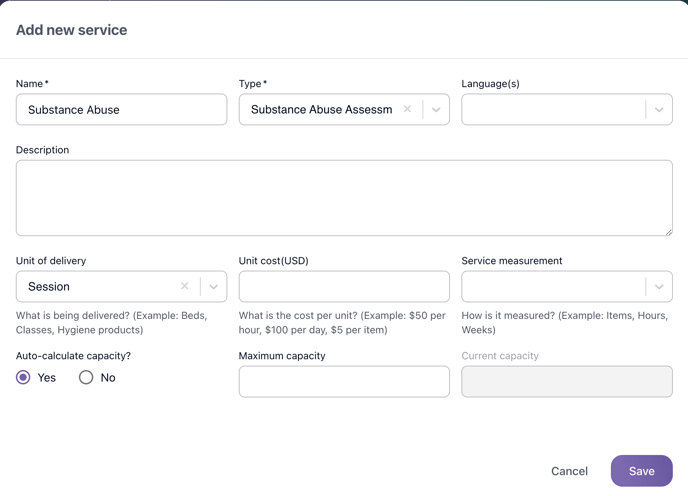
What kind of services does Casebook allow me to record?
Casebook will enable you to record and track:
-
Direct services you provide to your clients (for example, a caseworker providing transportation services, a therapist providing mental health counseling, etc.)
-
Services that will be provided by external service providers without any direct managing relationships (for example, a caseworker referring parents to parenting lessons but the caseworker does not directly manage the providers or may not know the specific provider used ever or until much later)
-
Search for services and availability offered by providers managed in CB Track (your contract or license)
It could be a one-time service or a recurring service like
-
Placement in residential care - offered as bed/night (kinship care)
-
Service administered at pre-determined frequency - in sessions $X/hour (therapy)
-
Object or objects (diapers & baby supplies, bus passes)
-
Cash assistance - fixed (bus pass)
-
Cash assistance - variable (gas card, rental assistance)
-
Ongoing service during case - case management or advocacy
In cb Track → Services, what does unit of delivery mean?
Think of 'unit of delivery' as the measurement of service your clients will receive. It could be anything from diaper boxes, bus passes, meal vouchers, and shelter beds to classes offered—each representing a unique way we support your clients and cater to their needs. In reporting, you can total or average the total units of a type of service delivered and know what that translates to in the real world. For example, 500 "units" of the diaper service in Agency 1 means 500 boxes of diapers delivered to Moms in the visiting nurse program, whereas 500 "units" in Agency 2 means 500 diapers were given to Moms during their open clinic.
If the 'auto-calculate capacity' is turned on, each time a client is enrolled in a service (in the service plan) or logs a service delivery in a note, the 'Current capacity' field increases by 1. This feature allows you to effortlessly monitor the current capacity in real-time.
-
When set to 'Yes': Each client enrollment or logged service delivery automatically increments the 'Current capacity' field by 1. This streamlines real-time capacity tracking.
-
When set to 'No': You have control to manually input values into the 'Current capacity' field, enabling manual tracking of service capacity based on your specific input needs.
What does the ‘Clients’ section show on a Provider record?
This section is either added to manually or autopopulated showing which individuals are enrolled in services offered by this provider. You can enroll a client in a service, and when the service is delivered, you can log service notes for those enrollments directly from this section. Alternately, if you enter a service enrollment on a case, your client's enrollment with this provider will automatically display here.
If your business process does not involve creating/working with a case, you can
-
Create a Provider profile for the Service provider.
-
List all the services offered by that provider under the ‘Services’ section of the provider profile.
-
Track the clients you've served, their service enrollments, and delivery specifics in the 'Clients' section of the provider's profile.
My organization doesn’t use cb Engage; we’re a foster family recruitment agency. I want to capture what services the kiddos are receiving, including information about placements at that family. How can I do that in Casebook?
Within cb Track, you can create the foster family placement as a service (tracked on your Agency's provider, the Foster Family provider or another provider including internal departments, other partner agencies, etc), and you can add kiddos as clients. Once added as clients the children are now enrolled as placements under the Foster Family provider profile.
Many of our agencies working with Foster Families will create the Foster Family as a provider profile, including the 1-2 caregivers as Provider People, and add the types of placement that the family is authorized to provide as the service.
Note: In some organizations, they will also use the License feature to track the type of placements that the Foster Family has been certified to provide in addition to the services.
I have been a Casebook user since 2020. I used to capture service interaction details on a different page called ‘Service interactions.’ Can I not use it anymore?
In our experience with more than 300 customers and our research spanning decades, we heard from customers and non-customers that ‘Service Note’ is a more intuitive way for most to log service delivery. Many social workers and counselors have used a paper notebook historically (and to this day!) so their initial behavior is to want to create a note for activities with clients. Hence, we added new fields to the ‘Service note’ type to help you to capture additional data related to the services offered.
I document service deliveries to clients as service interactions. What happens to my old data? Is it lost?
It is not lost. We have migrated all your data from service interactions to ‘Service notes.’ You can see them by clicking on the link ‘X service note’ (where X = a number)

I documented service deliveries to clients as service notes and included staff, clients as People Involved. What happened to my old service notes for multiple people?
This data is still accessible to you. On existing notes, you will see People Involved still appear although that information is uneditable. People Involved live only on existing notes.
On new notes, you will be able to select the Person providing service and the Service recipient.
Will a person's profile reflect these service enrollments and service notes?
Yes.
Is 'Service note' data available for reporting?
Yes.
What does ‘Number of service units’ mean?
This field works in conjunction with Unit of Delivery. When you enter the number of classes/beds/hygiene products you plan to provide the client(s), this will enable you to track total number of units of the service delivered over time. In addition, this field supports decimals like 1.5 (diaper boxes).
What does ‘Unit cost for this service’ mean?
This field allows you to enter the cost associated with a unit of the service you’re planning for the client(s). This value takes the value that you entered in cb Track for the service you choose in the ‘Service and Provider’ field.


This field can be overwritten to enter variable cost. For example, if you provide cash assistance of different amounts based on need or client’s income level.
What does ‘Total cost for this service’ mean?
This field is automatically calculated based on two factors: the 'Number of service units' and the 'Unit cost for this service.' It serves as a dynamic calculator for variable expenses associated with providing the service.
For instance, if you've incurred costs for an Uber ride provided to the family, you can input this amount into the field. The system then calculates the total expense by considering the number of service units (such as rides) and their respective costs, providing an accurate reflection of the total expense incurred for that particular service.
Our organization offers training to clients to get them placed. Is it possible to mark ‘attendance’ for class?
Currently, you can mark the attendance for an individual using ‘Service note.’
 cb Engage
cb Engage
My organization tracks cases in Casebook and provides services to families on a case. I want to capture each interaction my staff would have with the family when providing services. How can I do that in Casebook?
Within cb Engage, you can use the ‘Service Note’ type to capture the service delivery interactions. It allows you to capture what services you provided, the cost associated with it, and the date, time, and details of the interactions.
What is this new section ‘Service plan’?
This section can be used to plan and enroll the client(s) in appropriate services for the client(s) based on their needs and assessments.
This section will be updated in the future to allow tracking ‘Goals’ and ‘Outcomes.’
You can log service deliveries pertaining to the enrollments using ‘Add a service note.’ All the related service notes can be accessed by clicking on ‘X service notes.’
Will these case service enrollments be added to a provider profile in cb Track?
Yes, these case service enrollments will be displayed in cb Track-> Provider profile → ‘Clients’ section. You’re encouraged to add all service enrollments from within the Case, as it will then be identified as work completed as part of a case in the database. In the longer term, Casebook will support more detailed reporting on interventions and case outcomes.
Will a person's profile reflect these service enrollments and service notes?
Yes.
I want to capture enrollments planned or services delivered to a family. Is there a way to do this?
Option 1: You can add the family members to the case under the ‘People’ section and ‘Add services’ for them.
Option 2: You can log a service enrollment and search for the person you want to add in the ‘Service Recipients’ field. When you save the enrollment, the person gets added to the case automatically. Similarly, in the service note, search for the person you want to add in the ‘Service Recipients’ field and save the note; the person gets added to the case automatically.
Currently, ‘Service Recipients’ does not take multiple inputs at once. This feature is coming soon.
These people will be displayed in cb Track-> Provider profile → ‘Clients’ section as well with their service enrollments and service notes.
I have a family case; there are some instances where I want to capture one-time services provided like ‘The family was given emergency financial help to get groceries.’ Where can I capture it?
You can use the ‘Service Note’ type to capture the service delivery interactions. It allows you to capture what services you provided, the cost associated with it, date, time, and details of the interactions.
What does ‘Number of service units’ mean?
This field allows you to enter the number of classes/beds/hygiene products you plan for the client(s). This field accepts decimals like 1.5 diaper boxes.
What does ‘Unit cost for this service’ mean?
This field allows you to enter the cost associated with a unit of the service you’re planning for the client(s). This value takes the value that you entered in cb Track for the service you choose in the ‘Service and Provider’ field.

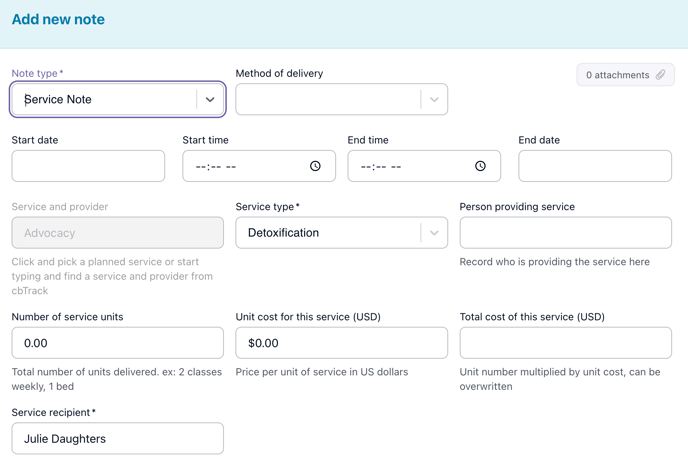
This field can be overwritten to enter the variable costs.
What does ‘Total cost for this service’ mean?
This field is automatically calculated based on two factors: the 'Number of service units' and the 'Unit cost for this service.' It serves as a dynamic calculator for variable expenses associated with providing the service.
For instance, if you've incurred costs for an Uber ride provided to the family, you can input this amount into the field. The system then calculates the total expense by considering the number of service units (such as rides) and their respective costs, providing an accurate reflection of the total expense incurred for that particular service.
What does ‘Planned start date’ and ‘Planned end date’ mean?
Think of these as the scheduled kickoff and expected wrap-up dates for providing the service to the client. They're there to plan when the service starts or is anticipated to finish, and you can even set them up for a same-day service if needed.
Just remember, these dates are what you're planning for, not the actual service dates. If things change, like if the service ends earlier than expected because the provider stopped offering it or the client moves to a different state, no worries. You can use the 'End service' option and note down the reason for the early wrap-up.
Where do you configure service types?
You can configure the service types dropdown from the cb Admin application under the Providers section and in the Fields tab. (cb Admin > Providers > Fields)
I’m a Casebook user since 2020. I used to capture service interaction details on a different page called ‘Service interactions’. Can I not use it anymore?
Previously, 'Service interactions' was the go-to spot for logging service delivery details. However, based on user feedback and research, we've streamlined this process. Now, the 'Service Note' feature offers a more intuitive way to record service delivery.
To enhance this, we've added new fields within the 'Service note' type. These additions allow you to capture even more data related to the services provided, making the 'Service Note' a comprehensive and efficient tool for documenting service interactions.
What happens to my old data? Is it lost?
It is not lost. We have migrated all your data from service interactions into ‘Service notes’. You can see them by clicking on the link ‘X service note’.

Is 'Service note' data available for reporting?
Yes.
I had a service planned for the client ‘Parenting classes’. The client cannot attend the service delivery event because of childcare issues. How can I say that the service delivery did not happen and the reason for it?
Currently, you can mark the attendance as No for an individual using ‘Service note’.


There is a field coming soon to help you to capture the ‘outcome’ of the service delivery.
I referred a client to a provider and found out that the capacity was full. So, I put them on their waitlist. Is there a way to indicate this in Casebook?
Good news! There will soon be a new status called 'Waitlisted' to indicate when a client is put on a waitlist.
In the future, Casebook aims to offer a complete workflow. This means providers will be automatically notified of the referral, and the waitlist status will update as the line progresses. Workers will also receive notifications as the client moves up the waitlist. This streamlined process will make managing referrals and waitlists smoother and more efficient.
cb Intake
My organization provides domestic violence support for our community members. Due to the nature of the program, during intake callers are provided with services like crisis intervention, safety, planning, and referrals even before they are screened in, and we create a case for them. How can I capture that in Casebook?
You can use the ‘Service Note’ type to capture the service delivery interactions. It allows you to capture what services you provided, the cost associated with it, date, time, and details of the interactions.
General Services FAQ
Can I edit a service's Actual End Date and Reason for ending service?
Yes.
Can I add a service enrollment from anywhere?
If you're working with clients within a case, it's best to enroll them for services within that specific case. This helps build connections between the services provided and the outcomes for the people involved. We're expanding fields to make these correlations clearer over time.
Now, not all organizations handle services within a case. For instance, community or homeless services often work with people directly. Users have the option to add service enrollments from both cb Track and cb Engage. But if your work is part of a case, it's a good practice to enroll for services directly within that case for more comprehensive tracking and alignment.
What do I have to do to take advantage of these changes?
To fully utilize these updates, here's what we recommend:
-
Adding Detailed Information to Service Offerings: Include the unit cost for services. This data will automatically populate service notes, simplifying cost calculations.
-
Specifying Reasons for Enrollment End: Head to Providers within cb Admin and set up options for the 'Reason for ending enrollment' field. This setup will reflect in both cb Engage and cb Track when you choose to 'End Enrollment' for a service enrollment. This feature allows for better tracking and understanding of events within service enrollments over time.
What kind of services does Casebook allow me to record?
Casebook will enable you to record and track:
-
Direct services, known as "service enrollments," that you offer to your clients. For instance, services like transportation provided by a caseworker or counseling sessions by a therapist.
-
Distinguishing between one-time services and those provided repeatedly over time.
-
Service enrollments facilitated by external service providers, where you might refer clients to external services like parenting lessons. In such cases, you may not directly manage these providers or immediately have detailed information, but Casebook allows for tracking these referrals and eventual service outcomes.
What are some use cases in which these services can be beneficial to our staff?
-
For Caseworkers: It allows tracking of self-provided services (such as client transportation) and those offered by external providers (like court appearances) for billing and time-tracking purposes.
-
For Direct Service Providers: Enables monitoring of services offered by both caseworkers directly employed and external providers, ensuring comprehensive tracking of all services rendered to clients.
Will my organization be able to report on the outcomes of these service enrollments?
Yes.
Will a person's profile reflect these new service enrollments?
Yes, all service enrollments will be displayed on a Person Profile.
Will these case service enrollments be added to a provider profile in cb Track?
No, these case service enrollments will only be displayed in cb Engage on a case record and on a person profile.
What does ‘outcome’ mean & is it configurable?
The outcome field enables you to track the outcome or progress of each service enrollment or service interaction your client is involved in.
Yes, the outcome dropdown is configurable. You can configure this dropdown from the cb Admin application under the cb Engage section and in the Fields tab. (cb Admin > cb Engage > Fields).
Where do you configure service types?
You can configure the service types dropdown from the cb Admin application under the Providers section and in the Fields tab. (cb Admin > Providers > Fields).
How are the provider/service search results sorted?
Our provider/service search field is powered by the Elasticsearch engine. Elasticsearch allows Casebook to fine-tune the search results so that the most relevant results are surfaced based on a user’s query. Elasticsearch is a highly tunable and flexible search index.
The search results returned by a user’s query are sorted by an Elasticsearch score. The search score is determined by a combination of the weights and filters that Casebook has configured and by Elasticsearch’s own internal dynamic metrics. The more relevant the user’s search term is to a particular record, the higher the score will be. The search results that are returned from a user’s query are ordered based on the search score; that score is a composite of Casebook defined rules and Elasticsearch’s internal metrics.
Services FAQ
My data
I used service interactions before now. What happened to my data?
It is not lost. We have migrated all your data from service interactions into ‘Service notes’. As a reminder, there are three types of service interactions in the old services experience:
-
External
-
Internal
-
cb Track directory
Here’s an example of a service interaction created on an external enrollment and migrated: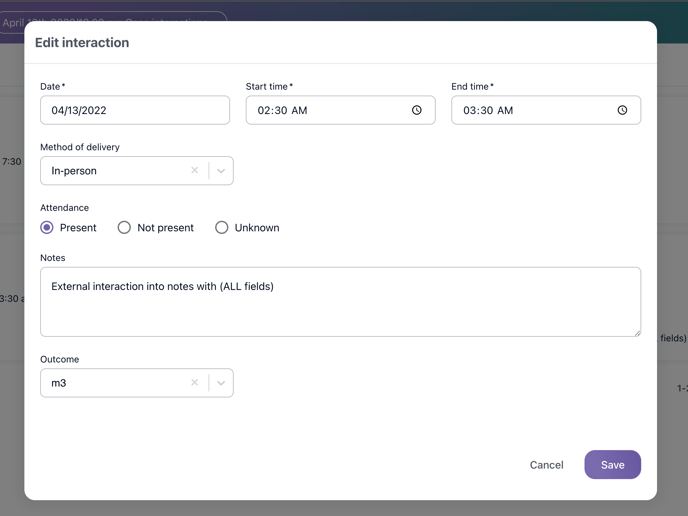
You can see service interactions by clicking on the link ‘X service note’. The service recipient appears as an avatar on the note record.
I can expand the service note and see more data. 

We’ve migrated all data except outcome and organization. Outcome and organization data is coming soon. This data is available in reporting now.
Internal
Here’s an example of a service interaction created on an internal enrollment and migrated. Note that there are multiple people in the interaction. We will be able to support multiple people in the future. All of this data may not be visible in the UI but it is in reporting.
When it’s migrated, it appears as a note. Service recipient is circled.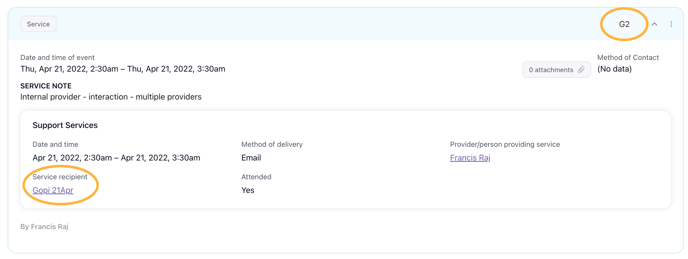
cb Track directory
Here’s an example of a service interaction created from cb Track directory.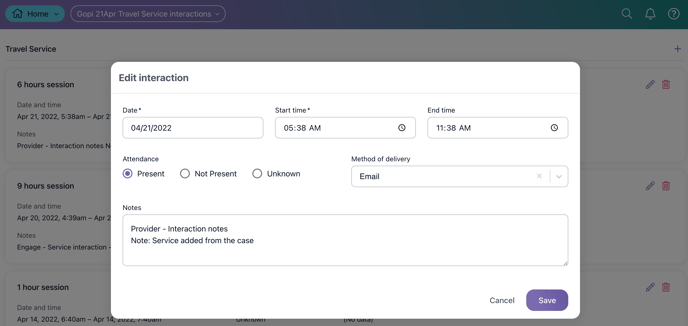
and migrated to a note.
I tried to edit an existing service note generated from a service interaction created before the migration, and I got a warning message. Why?
Please note that we’ve updated your service interactions to appear as notes. If a user updates a note with a new service recipient, the user will be overwriting information about service interactions.
This may be tempting for people who have multiple service recipients on a note but can only currently see one.
I tried to edit a new service note from before the migration, and I got a warning message. Why?
If a user creates a service note, saves, and then edits a service recipient, the user will be notified that this will overwrite existing information. A new service enrollment and new service interaction will be created.
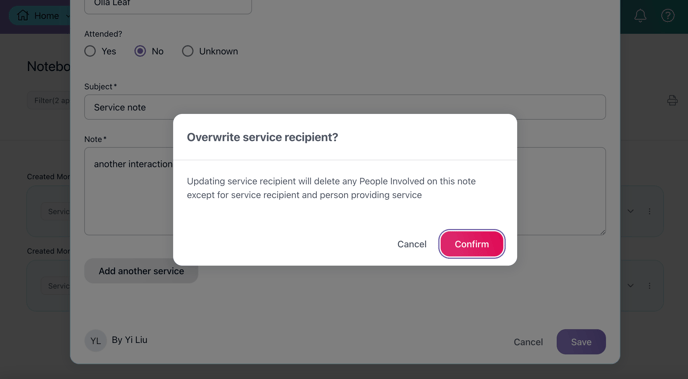
.png?width=1286&height=255&name=logo-raspberry%20(1).png)